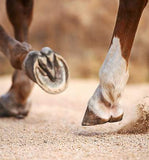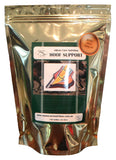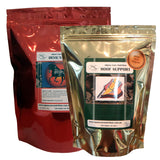Feeding the hoof: vitamins
 Last time we looked at the crucial part protein plays, and in particular the role of essential and non-essential amino acids, the major structural building blocks of protein. This time we will look at vitamins, and the role they play in synthesising protein in the horse's body.
Last time we looked at the crucial part protein plays, and in particular the role of essential and non-essential amino acids, the major structural building blocks of protein. This time we will look at vitamins, and the role they play in synthesising protein in the horse's body.
The principal vitamins involved in healthy hoof growth are the B group vitamins. These are: Thiamine (B1), Riboflavin (B2), Niacin (B3), Pantothenic Acid (B5), Pyridoxine (B6), Biotin (B7), Folic Acid (B9), and Cyanocobalamin (B12). B Vitamins are important to every organ and cell of the body. I personally cannot absorb B12 and need injections every three months, so I know from personal experience just how tired and lousy one feels with a B vitamin deficiency! All B vitamins are involved in the metabolism of protein, fat and carbohydrate which play very important roles in a tissue as metabolically active as the hoof, and many B vitamins also work together.
B vitamins are water soluble, floating freely through the fluids of the body and not stored in body tissue. They circulate around the body and are taken up by cells that need them or are eliminated as waste in urine. Due to this rapid elimination a horse must take in the B vitamins it needs on a constant daily basis.
In relation to the hoof, there are four B vitamins in particular that are of interest. Biotin (B7) has received publicity, with published studies that have demonstrated an improvement in hoof growth and quality from Biotin supplementation over time (at least 9 months of supplementation was needed to see positive results). Biotin contains sulphur, is involved in glucose metabolism, growth, the utilisation of Niacin (another B vitamin), and the maintenance of all rapidly dividing tissues.
Niacin (B3) is needed in the body for protein metabolism, important for hoof growth as the hoof wall is over 90% protein. Niacin is also used in the metabolism of fatty acids and cholesterol. The outer most layer of the hoof wall contains a variety of fats and waxes, which in a healthy hoof form an unbroken layer, sealing moisture into the deeper hoof structures and keeping water out. These fats and waxes give the outer layer of a healthy hoof a naturally slick feel and shine. Niacin is also required for copying DNA and the reproduction of cells, important in a tissue as metabolically active as hoof keratin.
Another B vitamin crucial to the metabolism of protein is Pyridoxine (B6). Last time we looked at essential amino acids which needed to be provided in the diet, and non essential amino acids which the body could synthesise itself. Well Pyridoxine is used in the body to synthesise the non essential amino acids alanine and glycine, which are two of the key building blocks of keratin, the major structural protein of the hoof.
The final B vitamin of note is Thiamine (B1) which is essential to the proper metabolism of carbohydrates, fats and proteins, and for cells to copy their DNA and reproduce themselves. Thiamine, like Biotin, also contains sulphur, which brings us to the final subject that we will look at next, when we examine the role that minerals play in the healthy hoof.
|
RELATED PRODUCTS |
|||
 |
 |
 |
 |
| Hoof Support |
Hoof Builder |
Omega-3 | Laminitis Recovery |